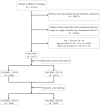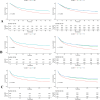The association between triglyceride glucose-body mass index and mortality in intensive care unit patients: a propensity score matching analysis
- PMID: 40887601
- PMCID: PMC12398970
- DOI: 10.1186/s40001-025-03128-8
The association between triglyceride glucose-body mass index and mortality in intensive care unit patients: a propensity score matching analysis
Abstract
Purpose: Triglyceride glucose-body mass index (TyG-BMI) represents a combined measure to evaluate insulin resistance and predict cerebral and cardiovascular disease risk and the resulting negative consequences. Nevertheless, the prognostic value of TyG-BMI for predicting outcomes, such as mortality, among critically ill patients in the intensive care unit (ICU-CIP) remains understudied. Our study seeks to ascertain the relation between all-cause mortality (ACM) and TyG-BMI among ICU-CIP, regardless of specific diseases, to recognize individuals at high risk and enhance prediction strategies.
Methods: The data were acquired from the Medical Information Mart for Intensive Care (MIMIC)-IV database, version 3.2, and estimated the TyG-BMI, incorporating fasting blood glucose, fasting triglycerides, and BMI. The formula used was ln{[fasting triglycerides (mg/dL) × fasting blood glucose (mg/dL)]/2} × BMI. Herein, we included all first-time admitted adult patients, evaluated their TyG-BMI., and conducted a 1:1 propensity score matching (PSM) approach to address possible confounding variables. The critical TyG-BMI level influencing patient survival was determined utilizing maximally selected rank statistics. Kaplan-Meier survival analysis along with multivariate Cox proportional hazards (PH) regression models were utilized to estimate the impact on short- and long-term ACM. Furthermore, restricted cubic spline (RCS) methods explored the linear or non-linear relation between TyG-BMI and ACM, with additional knowledge acquired from interactions and analyses of subgroups.
Results: A total of 9,175 ICU-CIP was included; after PSM, the analysis involved 3,642 matched participant pairs. Cox PH fully adjusted regression models demonstrated a significant correlation between higher TyG-BMI (≥ 239.54) and decreased 90 day ACM, both before (hazard ratio [HR] 0.77; 95% confidence interval [CI] 0.69-0.85) and after PSM (HR 0.76; 95% CI 0.68-0.85). Comparable associations were observed for 30 day, 180 day, and 365 day ACM. Post-PSM, RCS analysis revealed a negative L-shaped non-linear relation between both short- and long-term ACM and TyG-BMI. Notably, significant interaction effects were noticed in age, race/ethnicity, and hypertension subgroups, while no interaction effects were found in diabetes and gender subgroups.
Conclusion: TyG-BMI is a novel, non-invasive predictor of mortality in ICU-CIP. These findings may inform risk stratification and public health strategies, although validation in diverse populations is warranted.
Keywords: Biomarker; Critical ill; Intensive care unit; MIMIC-IV; Mortality; Triglyceride-glucose body mass index.
© 2025. The Author(s).
Conflict of interest statement
Declarations. Ethics approval and participation contents: The Institutional Review Boards at both the Massachusetts Institute of Technology (Cambridge, MA, USA) and the Beth Israel Deaconess Medical Center (Boston, MA, USA) authorized the study and guaranteed compliance with institutional policies and local laws. Consequently, participants or their legal guardians/next of kin were not required to provide informed consent, which is agreed with both institutional guidelines and national legislation. Competing interests: The authors declare no competing interests.
Figures







References
-
- Thorell A, Nygren J, Ljungqvist O. Insulin resistance: a marker of surgical stress. Curr Opin Clin Nutr Metab Care. 1999;2:69–78. 10.1097/00075197-199901000-00012. - PubMed
-
- Ljungqvist O. Insulin resistance and outcomes in surgery. J Clin Endocrinol Metab. 2010;95:4217–9. 10.1210/jc.2010-1525. - PubMed
-
- Chen Q, Hu P, Hou X, Sun Y, Jiao M, Peng L, et al. Association between triglyceride-glucose related indices and mortality among individuals with non-alcoholic fatty liver disease or metabolic dysfunction-associated steatotic liver disease. Cardiovasc Diabetol. 2024;23:232. 10.1186/s12933-024-02343-7. - PMC - PubMed
-
- Huang D, Zhong X, Jiang Y, Kong L, Ma R, Lu J, et al. Insulin resistance impairs biological agents response in moderate-to-severe plaque psoriasis: insights from a prospective cohort study in China. Br J Dermatol. 2024. 10.1093/bjd/ljae147. - PubMed
MeSH terms
Substances
LinkOut - more resources
Full Text Sources
Medical
Miscellaneous

